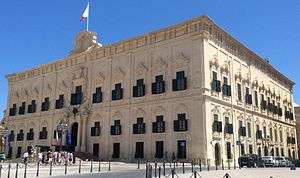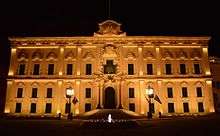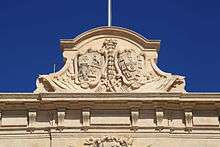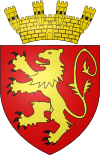Auberge de Castille
| Auberge de Castille | |
|---|---|
| Berġa ta' Kastilja | |
 Auberge de Castille after restoration | |
| General information | |
| Status | Intact |
| Type | Auberge |
| Architectural style | Spanish Baroque (originally Mannerist) |
| Location | Valletta, Malta |
| Coordinates | 35°53′45″N 14°30′41″E / 35.89583°N 14.51139°E |
| Current tenants | Office of the Prime Minister of Malta |
| Completed | 1574 |
| Renovated |
1741–1744 1791 |
| Owner | Government of Malta |
| Technical details | |
| Material | Limestone |
| Floor count | 2 |
| Design and construction | |
| Architect | Girolamo Cassar |
| Renovating team | |
| Architect | Andrea Belli |
The Auberge de Castille (Maltese: Berġa ta' Kastilja) is an auberge in Valletta, Malta. It was originally built in the 1570s to house knights of the Order of Saint John from the langue of Castile, León and Portugal. The present building dates back to the 1740s, when it was completely rebuilt during the magistracy of Manuel Pinto da Fonseca. The new auberge was built in the Baroque style, and it has been called "probably the finest building in Malta". It now houses the Office of the Prime Minister of Malta.
The auberge is located in Castille Square, close to Saint James Cavalier, the Malta Stock Exchange and the Upper Barrakka Gardens. It is situated at the highest point of Valletta and overlooks Floriana and the Grand Harbour area.
The name Castille (or Kastilja in Maltese) is often used as a metonym to refer to the Prime Minister and his office, in a similar sense to how the White House is used to refer to the Executive Office of the President of the United States.
History
Hospitaller rule
Auberge de Castille was originally built in 1573–74 to designs of the architect Girolamo Cassar.[1] The original auberge, which took over the role of an earlier Auberge de Castille et Portugal in the former capital Birgu, was built in the Mannerist style, and it was regarded as Cassar's most innovative design. The auberge had a single storey, and its façade had panelled pilasters dividing it into eleven bays. The design of the auberge is known from a late 17th-century painting and an early 18th-century drawing.[2][3]
The original Auberge de Castille was dismantled and completely rebuilt in the Spanish Baroque style between 1741 and 1744, during the magistracy of Grand Master Manuel Pinto da Fonseca. The new building was built to designs of Andrea Belli, and construction was supervised by capomastro Domenico Cachia.[1] Some alterations, including the enlargement of the main door, were made in 1791.[4]
French occupation and British rule
_Art.IWMART3120.jpg)
The Order of St. John was expelled from Malta with the French invasion and occupation in 1798. The auberge subsequently became a headquarters for the French forces, and it later housed a Commission for National Property.[4] The building suffered some damage during the blockade of 1798–1800.[5]
After Malta became a British protectorate, in 1805 the auberge became the headquarters of the British armed forces in Malta. It was also used as a residence for British officers. In 1814, a disabled contingent from the army of Egypt was accommodated in the auberge. A Protestant chapel was opened in one of the rooms of the first floor in 1840. A signalling station with a large aerial was installed on the roof in 1889 to communicate with warships of the Mediterranean Fleet moored in the Grand Harbour.[6]
The then princess, now Queen Elizabeth II, has worked with the Soildiers, Sailors, Airmen Families Association (SSAFA) when it was housed at Auberge de Castile.[7]
In 1942, during World War II, the right side of the building was damaged by aerial bombardment.[4] The damaged parts were later repaired, and the aerial was removed. The auberge was also used as the General Headquarters of the Army for Malta and Libya, and also for Cyprus after 1954.[6]
Independent Malta

On 4 March 1972, the Office of the Prime Minister of Malta moved from Auberge d'Aragon to Auberge de Castille.[5] The Prime Minister leads the business of the government from the auberge, and the name Castille (or Kastilja in Maltese) is often used as a metonym to refer to the Prime Minister and his office.[8]
Over the years, some of the stonework began to crumble and the façades were blackened. The building was restored between 2009 and 2014.[9]
The building was included on the Antiquities List of 1925 together with the other auberges in Valletta.[10] It is now scheduled as a Grade 1 national monument by the Malta Environment and Planning Authority, and it is also listed on the National Inventory of the Cultural Property of the Maltese Islands.[1]
Architecture

Auberge de Castille is built in the Baroque style, and it is a two-storey building with a rectangular plan and a central courtyard. Its façade is divided into eleven bays defined by pilasters in the central bays or plain panelling in the outer bays. Ornate windows are set within recessed panels. The building has a continuous cornice, and its corners are rusticated.[1]
The main entrance is approached by a flight of steps, and the doorway is flanked by columns which support a trophy of arms and a bronze bust of Grand Master Manuel Pinto da Fonseca.[11] A moulded window is located above the bust, and it is surmounted by Pinto's coat of arms.[12] The centrepiece above the window bears the coats of arms of Castile and León and of Portugal.[1] Just in front of the entrance are two historic canons, now used for decoration.[13]
The auberge has been called "probably the finest building in Malta".[14] Both the exterior and the interior, especially the ornate façade and the steps leading to the doorway, were designed to be imposing.[15][16]
Auberge de Castille is linked to Auberge d'Italie across Merchants Street through a World War II-era underground air-raid shelter.[17]
Commemorative coins
Auberge de Castille was depicted on two commemorative coins minted in 2008 by the Central Bank of Malta. The coins show the auberge's portico on the reverse and the coat of arms of Malta on the obverse.[18]
Further reading
- The rock cut mezzanine rooms are the only remains of the first auberge but the ceilings were modified.
References
- 1 2 3 4 5 "Auberge de Castille et Leon" (PDF). National Inventory of the Cultural Property of the Maltese Islands. 28 December 2012. Archived from the original (PDF) on 4 March 2016.
- ↑ "The first Auberge de Castille". angelfire.com. Archived from the original on 10 March 2016.
- ↑ Bonello, Giovanni (2000). Art in Malta - Discoveries and Recoveries. Fondazzjoni Patrimonju Malti. p. 41. ISBN 99909-959-7-4. ISBN 99909-959-8-2.
- 1 2 3 "Auberge de Castille – Valletta". Restoration Directorate. Archived from the original on 1 February 2016.
- 1 2 "Auberge de Castille". Office of the Prime Minister. Archived from the original on 5 July 2008.
- 1 2 "History of Auberge de Castille". CulturalMalta. Archived from the original on 2 March 2013.
- ↑ Hicks Pamela (2013), "Daughter of Empire: My Life as a Mountbatten", Simon and Schuster, p. 171.
- ↑ "Deputat tal-PN tallega li hemm 'direct link' bejn Kastilja u l-MEPA". iNews Malta (in Maltese). 16 June 2016. Archived from the original on 21 June 2016.
- ↑ "Last scaffolding comes down as five-year Castille restoration is completed". Times of Malta. 13 July 2014. Archived from the original on 13 November 2014.
- ↑ "Protection of Antiquities Regulations 21st November, 1932 Government Notice 402 of 1932, as Amended by Government Notices 127 of 1935 and 338 of 1939.". Malta Environment and Planning Authority. Archived from the original on 20 April 2016.
- ↑ Playfair, Robert Lambert (1881). Handbook to the Mediterranean, Volume 2 (Murray). p. 184.
- ↑ Sacheverelle, Sitwell (1958). Malta (Bastford). p. 27.
- ↑ Stuart, Rossiter (1968). Malta (Benn). p. 68.
- ↑ Ellul, Michael (1982). "Art and architecture in early nineteenth century Malta" (PDF). Proceedings of History Week: 3. Archived from the original (PDF) on 3 April 2016.
- ↑ "Il-Palazzi tal-Belt Valletta". Air Malta (in Maltese). Archived from the original on 17 June 2016.
- ↑ A Handbook.... p. xxxix. (39).
- ↑ "The fascination of underground Valletta". The Malta Independent. 28 October 2012. Archived from the original on 3 September 2016.
- ↑ "Europa Programme 2008 with the theme of 'Cultural Heritage' – Auberge de Castille". Central Bank of Malta. Retrieved 10 April 2016.
![]() Media related to Auberge de Castille at Wikimedia Commons
Media related to Auberge de Castille at Wikimedia Commons
.svg.png)
